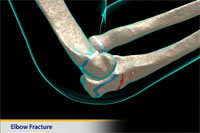
Elbow Fracture: Olecranon Fracture
What is an olecranon fracture?
Most often a broken elbow is a crack or break in the part of the elbow called the olecranon. The olecranon is the bony tip that you feel directly under the skin of the elbow. It is at the end of the lower arm bone called the ulna.
What is the cause?
A broken elbow usually happens from a fall or a direct hit to the elbow.
What are the symptoms?
Symptoms may include:
- pain, especially when your child moves the elbow
- trouble bending or straightening the elbow
- swelling
How is it diagnosed?
Your provider will ask about your child’s symptoms and how the injury happened. He or she will examine you child. Your child will have X-rays of the elbow.
A child's bones are different from an adult’s bones in a couple ways. A child’s bones are more flexible and may crack rather than break. Or they may just buckle slightly. Also, the bones are still growing from areas near the ends of the bones called growth plates. A fracture in a growth plate may affect the growth of the bone but it may be hard to see with X-rays. Sometimes special tests are needed to diagnose fractures in the growth plate.
How is it treated?
The treatment depends on the injury.
- If just a small piece of bone is broken at the end of the bone it may be treated with a splint or cast.
- If a larger part of the bone is broken, or if the break goes into the joint, surgery may be needed to repair the bone. Your healthcare provider may use a pin or screw to keep the broken bone in place.
- Sometimes the injured bone gets dislocated, which means it has moved out of place in the elbow joint. This is called a dislocation. If the joint is dislocated, then it will need to be put back into place.
While it heals, the injured arm will be in a splint or cast. The injured arm may also need to be in a sling to keep it from moving while it heals.
How can I take care of my child?
Follow the full course of treatment your healthcare provider prescribes. Also:
- To keep swelling down and help relieve pain, your healthcare provider may tell you to:
- Put an ice pack, gel pack, or package of frozen vegetables wrapped in a cloth on the injured area every 3 to 4 hours for up to 20 minutes at a time for the first day or two after the injury.
- Keep the injured arm up on pillows when your child sits or lies down.
- Give your child pain medicine, such as ibuprofen, as directed by your provider. Nonsteroidal anti-inflammatory medicines (NSAIDs), such as ibuprofen, may cause stomach bleeding and other problems. These risks increase with age. Read the label and take as directed. Unless recommended by your healthcare provider, your child should not take the medicine for more than 10 days. Check with your healthcare provider before you give any medicine that contains aspirin or salicylates to a child or teen. This includes medicines like baby aspirin, some cold medicines, and Pepto-Bismol. Children and teens who take aspirin are at risk for a serious illness called Reye's syndrome.
- If your child has a cast, make sure the cast does not get wet. Cover the cast with plastic when your child bathes. Avoid scratching the skin around the cast or poking things down the cast. This could cause an infection.
Depending on the type of injury and how it was treated, your child may need to do special exercises to help the arm get stronger and more flexible. Most of the time preteen children are so active that their arm gets stronger and more flexible without physical therapy.
Keep all appointments for provider visits or tests. Call your healthcare provider if:
- Your child has more pain, redness, warmth, or swelling.
- Your child has a fever.
- Your child has a loss of feeling in the injured area.
- The injured area looks pale or blue or feels cold.
How long will the effects last?
Children tend to heal faster than adults, but healing times are different from one person to the next. As a rule, most fractures heal in 4 to 6 weeks.
How can a broken elbow be prevented?
Many elbow injuries are caused by falls or blows that are not easy to prevent. Knee pads, elbow pads, and a helmet can help prevent injuries during biking, rollerblading, or skateboarding.
Last modified: 2012-01-27
Last reviewed: 2012-01-02

